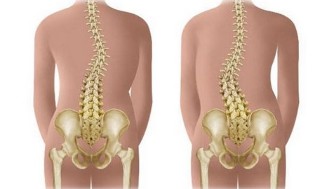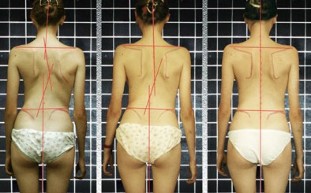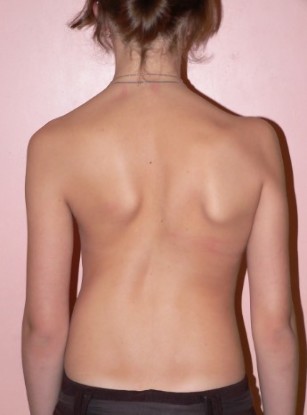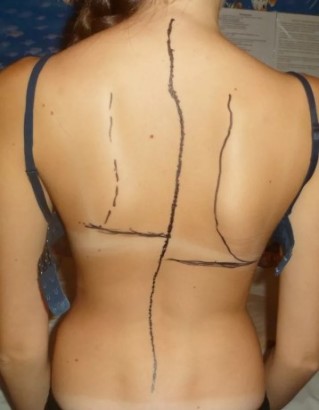In Greek it is the word "scolios", which translates as "the curve". That's the word that doctors refer to the curvature of the spinal column. And not every warp, and it is the reason, the lateral deviation of the vertical axis of the spine. The fact is that in the standard our spine is not perfectly smooth. Available in front and rear direction of the bend (lordosis and kyphosis) protects our spine from undue stress while keeping the body in a certain position during the movement and portability of weights. Negative processes in our body are developing just in those cases, if these kyphosis and lordosis expressed above the allowable standards.

The basic problems
However, even a small degree of lateral bends (scoliosis) of the spine – it is always a pathology. And not only in a cosmetic defect. Even if it is the characteristic gross appearance during an explicit or advancing scoliosis – it is always a tragedy for the person who is trying to live a quality and fulfilling life. In particular, it refers to young boys and girls. I mean, just in the children's and young period (up to 15 – 16 years old) diagnosed with a significant portion of the scoliosis.
The main problem is that because of configuration changes and the volume of the chest in the expression of lateral curvature always suffer from the internal organs (heart, lungs, stomach, liver, intestine, large blood vessels). In men with reduced tolerance to physical stress, in women have trouble conceiving, bearing pregnancy and childbirth. In addition, very often the lateral deformity of the spine – this is just the surface part of the iceberg, which is a sign of a much more serious pathology – tumors, tuberculosis, endocrine disorders.
Reasons
So why deformed spine? Before answer the question, determine the types of scoliosis. In essence, scoliosis can be structural and non-structural. Structural scoliosis develop as a result of anatomical changes in the structure of the bone tissue of the vertebrae, as well as being in the vicinity of the muscles, nerves, ligamentous apparatus. Such curvature may be purchased and birth, while in the last share is about a quarter of all diagnosed scoliosis.
Among the main causes of the development of structural scoliosis excludes:

- Malformations of the fetus, leading to dysplastic case of violation of one or more vertebrae
- Congenital developmental abnormalities of the chest – the lack of ribs, other ribs
- Congenital pathology of connective tissue disorders – neurofibromatosis, Marfan syndrome
- Brain failure due to cerebral palsy (CP), which leads to disruption of innervation of the certain sections of the spine
- Osteoporosis (vacuum bones) of the spine in rickets, diseases of the parathyroid glands to secrete, lack of calcium intake with food
- Osteomyelitis of the vertebrae
- Degenerative changes of the neck, thoracic and lumbar muscles
- TB damage to the vertebrae
- Injuries of the spine
- Tumors of the spine.
Non-structural scoliosis, as is clear from the name itself – is that the lateral deviations of the axis of the spine the pillar in their unaltered house of the vertebrae. As usual, such as scoliosis occur most frequently purchased, with the exception of those cases when the curvature of the worn compensatory in nature with congenital anatomical defects of the pelvis or the lower extremities. Reasons such as scoliosis are most often:
- Injuries of the pelvis and lower limbs
- Congenital defects of the pelvis and lower limbs
- Constant poor posture in school children
- Disorders of the internal organs are asymmetrically accompanied by syndrome pain
- Muscle inflammation (myositis)
- Burns, scars, soft tissue from one side.
In these cases, for the removal of the curvature of the spine in a sufficiently cure the underlying disease, and therefore a lot of non-structural scoliosis are easily reversible. In this regard, some doctors tend to not recognize non-structural deformation to the scoliosis at all.

Recently, the cases of development in young people scoliosis with excellent reasons. This is the so-called idiopathic scoliosis. It's in his teenage years, in a period of rapid growth of the organism. And girls suffering from idiopathic scoliosis several times more often than young men. It seems that it is related to the relatively weak muscles of the back in the female sex, which is not able to close the spine in the complete muscle skeleton. Not the last role in the development of idiopathic scoliosis plays an unbalanced diet with a low content of calcium salts, the madness of youth sodas. It is known that carbon dioxide in the bubbles and phosphoric acid in the composition of the synthetic inclusions contribute to wash out the calcium salts from the body.
Kinds and degrees of
Depending on the localization of the scoliosis can be cervical, thoracic, lumbar, or mixed (the neck-the thoracic, the lumbar-thoracic). Maybe the presence of one or several arcs of curvature. In this regard, we distinguish between S-shaped scoliosis (1 arc), S-shaped (with 2 arches) and Z-shaped (3 arches). Most likely, the presence of 2 or 3 doug wears compensatory in nature. In S-shaped scoliosis of the axis of the spinal pillar deviates. Trying to compensate for the fact that the spine bends to the opposite side. In this context, scoliosis is divided into compensated and uncompensated. In the matched curvature of the spine, the vertical line, to omit from the 7th century to the cervical vertebrae, passes through the crease between the buttocks.
Curvature of the spine is quite often worn in combination character. For example, in the infant department in addition to the lateral curvature of the celebrated pathological kyphosis, or simply the hump. In these cases we are talking about the mother in kyphoscoliosis . In addition, when larger degrees of scoliosis in addition to the lateral displacement of the vertebrae celebrated torsion. In a verbatim translation, it means twisting. Indeed, in many of the scoliosis is happening twisting of the bone tissue of a vertebra on the vertical axis.
Depending on the size of the angle of the arc of curvature shall be issued by 4 degrees of scoliosis:
- 1 degree – the angle of curvature is not larger than 10 degrees. The asymmetry of the eye almost is not intended. Draws the attention of the stoop, the uneven level of the shoulder girdle.
- 2 degree – angle of curvature ranges from 11 to 25 degrees. In this range already celebrating the torsion of the vertebrae. Observed is visible to the eye of the asymmetry of the shoulder girdle and the pelvis. Due to a malfunction of the tension of the muscles form the muscle cushion in the lumbar area with the concave side, and in the thoracic region – with the convex.
- 3 degree – of curvature ranges from 26 to 50 degrees. Visible deformation of the chest – retraction of the intercostal space with the concave side of the curvature and convex with convex. The weakening of the abdominal press, the shaping of the inner hump.
- 4 degree – angle curvature of the I exceeds 50 degrees. A significant cosmetic defect, and all previous symptoms. Low portability even less physical exertion. In addition to the musculoskeletal system suffer from internal organs.

The angle may vary depending on the position of the body, when it issued a stable and an unstable scoliosis. In an uncertain scoliosis decreases in a lying down position, when reducing the load on the spine. Thanks to the stable curvature of the spine, this value remains unchanged.
Symptoms
Recently podiatrists often use the term "scoliotic disease". And denote the complex of the negative changes that occur in the body when the curvature of the spine. As usual, scoliotic disease develops in childhood and at a young age, in the period of the formation of the musculoskeletal system. At this time, there's a good chance that the scoliosis will progress.
It seems that is not the last role in increase of the angle of twist of the play of the intervertebral disc. In a side bias of drive experienced uneven pressure from the sides of the vertebral bodies. With the concave side pressure is greater, with a convex – less. As a result, the disk even more wear out from the side of the scoliosis, is created by a pathological muscle tension (muscle roller) and the torsion of the vertebrae – all this leads to the formation of disc hernia and to further increase the twist angle.

Along with the spine when scoliosis of the disease, secondary changes chest. Form a so-called rib hump – with the convex side of the curvature of the intercostal intervals, extend, and with a concave – on the contrary, sink. When scoliosis 4 degrees of deformation of the chest becomes the comment that lower ribs on the side of the curvature of the overlap with the ridge of the hip bone.
Due to the significant deformation of the chest a complete inspection of it during respiration difficult. Eventually the body when expressed scoliosis doesn't get the required amount of oxygen – develops so-called chronic hypoxia in violation of all metabolic processes in the body. The pathology of the exacerbated by the fact that changing the internal volume and shape of the thoracic cavity. For this reason, the blood circulation is disturbed in the containers, suffers from the lungs, changes the shape of the heart developing chronic cardiovascular respiratory failure.
Similar changes happen in the organs of the abdominal cavity with lumbar and lumbar-thoracic scoliosis. Decreases motor skills of the stomach and intestines with subsequent enzymatic insufficiency of digestive glands. All this only exacerbates metabolic disorders. These disorders often lead to delayed of the penis maturation of boys and girls. In addition, because of the lumbar scoliosis secondary to a twisted pelvis. This creates problems for future moms, with the bearing of pregnancy and with childbirth.
Diagnosis
The diagnosis of scoliosis, especially the big titles, usually does not present any difficulties. For the detection of the deformation of the spine often enough to conventional visual inspection. Highlights the visible curvature of the contour of the spine, asymmetry of the shoulder girdle, the angles of the blades, the secondary curvature of the pelvis and shortening of the lower limb on the side of the curvature.
In the presence of at least one of these symptoms is indicated in radiography of the spine column. On the on the radiograph determine the configuration, degree and location of curvature. In the course of the examination and x-ray studies it is possible to set whether the scoliosis compensated and stable. Recently was distributed a qualitatively new method of investigation of the spine – magnetic resonance imaging (MRI), during which on the screen of the monitor, you can get a three-dimensional image of the spine. When significant curvature is a need to explore the work of the internal organs – spend spirometry, electrocardiography, perform an ULTRASONIC examination of the heart and internal organs.
Treatment
Treatment of scoliosis can take place both conservatively and operationally. To conservative methods include treatment treatment, massage, physiotherapy, manual therapy. In this case it is necessary to take into account that the final shaping of the spine is terminated to 20 years, and after this age, the correction of the curvature is nearly impossible. When scoliosis 1-2 degree of effort is focused on achieving the original, normal configuration of the spine. If they are expressed scoliosis 3 – 4 degrees, that is unattainable, the main thing here – to stabilize the spine and prevent the progression of scoliosis.

Drugs (chondroprotectors, vitamins, tonic preparations) in the treatment of scoliosis play only a supporting role. Strengthen muscles, remove muscle roller, and even to a large extent to stabilize the spine, it is possible with the help of massage and manual therapy. Good effect give the physical therapy sessions. But here, in the absence of physical exertion amplifies the instability of the spine and scoliosis progresses. Therefore, it is a set of exercises is developed for each patient individually with regard to the localization and severity of the curvature. When a large degree of scoliosis is contraindicated running, strength exercises, jumps, motion games.
Very good result gives a correction of the position – creates optimal posture, contributes to the normalization of posture. For this we use special products, orthopedic crib in which the young patients spend a considerable part of their time. When ineffectiveness of conservative measures, the progression of torsion is referred to operative treatment, aimed at stabilizing the spine. Surgical correction is not shown in early childhood, her behavior at a young age, when the formation of the spine is almost completed.




























